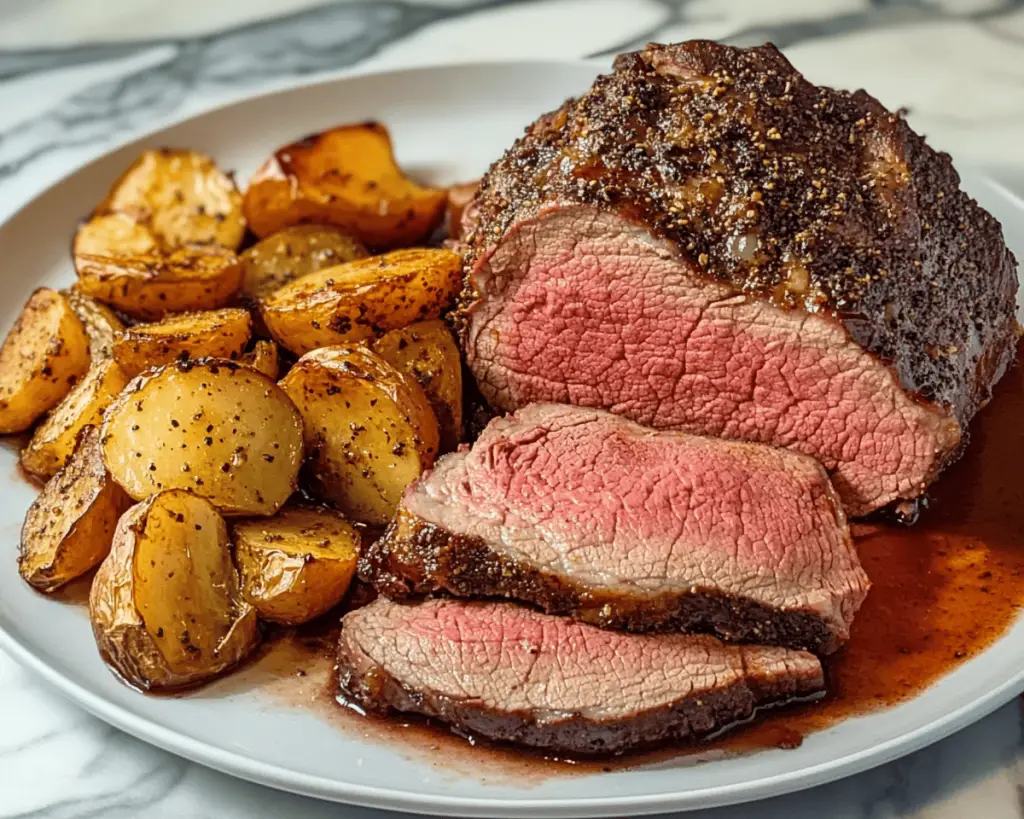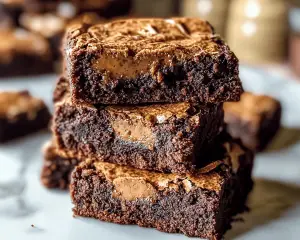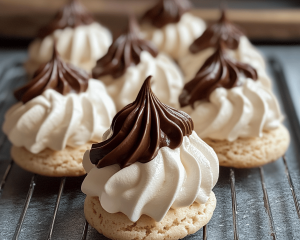I have a special place in my heart for **Classic Roast Beef**. You see, it’s not just another dish on the dinner table for me; it’s a bridge to memories of family gatherings, laughter around the dining room, and the comforting scent of a savory roast slowly cooking away on a lazy Sunday afternoon.
The very first time I stood in the kitchen, apron tied and hands slightly trembling, was when I was trying to replicate my mother’s roast beef. I was probably no more than ten years old, and my kitchen skills were limited to opening a box of mac and cheese. Watching her work her magic with a seasoned slab of beef was mesmerizing. I remember asking, “Mom, how do you make it so tender?” She would chuckle and say, “It’s all about the love, sweetheart—and a bit of practice.” Those words stuck with me, and as I have roamed through kitchens over the years, each roast reminds me of her, even when it comes out slightly overcooked or the gravy is a bit too thick.
And trust me, I’ve had my fair share of roast beef calamities. Like the time I invited a dozen friends for dinner, aiming for a glorious Sunday feast. In my ambitious enthusiasm, I mistakenly bought a cut of meat that was too lean. It turned out drier than the Sahara, and amid bouts of laughter around the table, I learned a vital lesson: it’s the fat that gives life to the roast. Since then, I’ve mastered the art of finding the *perfect cut*, and I can confidently say this recipe is a culmination of love, experience, and a few good comedy evenings lost at the dinner table.
So, if you’re looking to create a dish that warms your heart and delights your taste buds, let’s dive into making a Classic Roast Beef that’ll have everyone at the table reminiscing—maybe about their own kitchen disasters!
What Goes Into Classic Roast Beef?
Let’s break down each of the ingredients because, as my mother used to say, “The heart of a meal lies in what you put in it.”
– Beef Roast: The star of the show! I usually go for a good quality chuck roast or a prime rib if I’m feeling cheeky. The chuck has just the right amount of fat marbling, keeping it tender and full of flavor. Honestly, I often find myself at my friendly butcher’s shop, chatting about what cuts they have on sale. If you really want to impress, a prime rib is your golden ticket—but ensure it’s well-marbled.
– Salt: I could write a love letter to salt! It enhances every flavor. If I’m in a pinch, I’ll use kosher salt since I love how it brings out the beef’s natural flavors without being harsh. A helpful tip from my dad—always salt it ahead of time. Some say a night before if you have the luxury; it really penetrates the meat better that way.
– Pepper: Freshly cracked! I learned the hard way that using pre-ground pepper just doesn’t cut it. The aroma of fresh ground pepper is enough to transport you to a cozy bistro.
– Garlic: The more, the merrier! I usually go for 4-6 cloves. Here’s the thing—smash them a bit and leave the skins on while roasting. They’ll become delicious nuggets of flavor that you can sprinkle through your dish at the end!
– Fresh Herbs: I love using rosemary and thyme! Their fragrance drifting through the house while the roast is cooking creates an atmosphere that’s just pure joy. If you have a little pot next to your kitchen window like I do, you can snip fresh ones straight from there—talk about garden-to-table!
– Beef Broth: A good-quality broth adds a depth of flavor to the pan drippings for your gravy later. Sometimes, I toss in a splash of red wine; it adds a little “je ne sais quoi” that my friends love.
– Vegetables: Carrots, onions, and celery make for a fantastic base in the roasting pan. They soak up those lovely juices, giving you flavor bombs to add to your gravy later. I can’t help but make a bit of extra to nibble on while I cook—life is too short not to enjoy the simple things!
Every time I prepare this roast, I feel it in my bones—this isn’t just food; it’s something so much more—an embodiment of togetherness, laughter, and the essence of home.
Is Classic Roast Beef Actually Good for You?
Now, here’s the real talk about this roast beef. On one hand, yes, it can be considered indulgent—the sight of that glistening, perfectly cooked piece of meat can make you forget any self-control you had vowed to uphold. But hear me out—this roast actually brings a *fair share of nutrients!*
Let’s break it down:
– Protein: This dish is a great source—essential for muscle growth and overall bodily function. So, if you’ve been lifting weights or just chasing after kids, a solid slice of roast beef can feel like a victory.
– Iron: A good cut of beef is rich in iron, which aids in transporting oxygen in your body. You know, the kind of thing that helps keep you from feeling sluggish!
– Zinc: Often underrated, zinc is crucial for a strong immune system. So feasting on this roast not only fills your belly but protects you too.
However, I keep in mind portion control and balance—my plate won’t always be heaped with roast beef every night! A little creamy mashed potatoes and fresh veggies on the side make it feel complete and balanced.
Here’s What You’ll Need
– 3 to 4 pounds of chuck roast or prime rib
– 1 tablespoon kosher salt (more for taste)
– 1 teaspoon freshly cracked black pepper
– 4 to 6 cloves of garlic
– 2 tablespoons fresh rosemary, chopped
– 2 tablespoons fresh thyme, chopped
– 2 cups beef broth
– 1 onion, quartered
– 2 carrots, chopped
– 2 stalks celery, chopped
– A splash of red wine (optional)
This will typically serve about 6-8 people, depending on how much they love to eat (or how much you love to share!).
How to Make Classic Roast Beef Step-by-Step
Alright, let’s get down to business. This is where the magic happens!
1. **Prepare the Meat**: Start by taking your roast out of the fridge about 1 hour before you plan to cook it. This helps it cook more evenly. Honestly, it’s also a good time to sit down with a cup of tea and relax—it’s a marathon, not a sprint!
2. **Preheat the Oven**: Set it to 450°F (232°C). Let’s get that oven nice and hot!
3. **Season the Roast**: Generously rub salt, pepper, chopped garlic, rosemary, and thyme all over the roast. Don’t hold back; this is where you give your meat some love. When I sprinkle it on, I think to myself, “This roast is going to be the star of the show!”
4. **Brown It**: In a large oven-safe pan, heat a tablespoon of oil over medium-high heat. Sear the roast for about 4-5 minutes on each side until it’s beautifully browned. This caramelization? Ohhh, it’s the holy grail of flavor!
5. **Add the Vegetables**: Once the meat is browned, scatter the onions, carrots, and celery around it, almost like they’re pleading for attention. Pour in the beef broth (and wine, if you’re using it) until it reaches about halfway up the sides of the roast.
6. **Roast It**: Place the pan in the preheated oven. Roast at 450°F for 15 minutes to get that initial sizzle. Then reduce the temperature to 325°F (163°C) and continue roasting for about 1.5 to 2 hours, or until the internal temperature hits around 135°F (57°C) for medium-rare. Here’s my hint—use a meat thermometer!
7. **Rest the Roast**: Once it’s out, wrap it in foil and let it rest for at least 20 minutes. It’s so hard to resist, but this step is crucial. Patience, my friend!
8. **Make the Gravy**: Use the drippings left behind in the pan. Pour it into a saucepan, heat it on medium, and thicken with a bit of flour mixed in water if necessary. Use a whisk and make sure it keeps whisking smoothly to avoid lumps—nobody wants lumpy gravy!
9. **Serve**: Thinly slice the roast the against the grain and plate it with those delightful veggies and rich gravy. It’s like a hug on a plate.
Little Extras I’ve Learned Along the Way
Okay, let’s get creative here! I’ve picked up a few tricks and variations over the years that take this classic dish to the next level:
– **Spice it Up**: I’m a fan of mixing in a tablespoon of Dijon mustard or horseradish to the rub occasionally. It adds a lovely zing!
– **Veggie Variety**: Sometimes, I throw in parsnips, potatoes, or even sweet potatoes instead of the usual carrots and celery just to keep things exciting. It all cooks down to that rich flavor you can savor.
– **Slow Cooker Option**: If you’re crunched for time, consider throwing the seasoned roast in a slow cooker. You’ll want to sear it first, then place it on low and let it do its magic over 6-8 hours. Perfect for a laid-back Sunday.
– **Leftover Phenomenon**: If there are any leftovers (which is always a big if in my house), they make for the most glorious sandwiches. Add a little horseradish sauce and fresh arugula, and you’ll be living your best life.
– **Gravy Galore**: Don’t skimp on the gravy; I usually save a bit to drizzle on my leftovers. It takes a simple meal to gourmet status!
This roast means more to me than just a meal; it’s *about connection*. Each time I prepare it, I feel my family’s presence around me, and I can’t help but smile. The laughter, the stories, and the warmth that comes from sharing food—what could be better than that?
So, if you’re ready to create memories like I have, dive in and give this Classic Roast Beef a try. I hope it brings you all the joy it has brought me over the years. And hey, I’d love to hear how yours turns out or what little tweaks you make along the way. Enjoy every bite!



